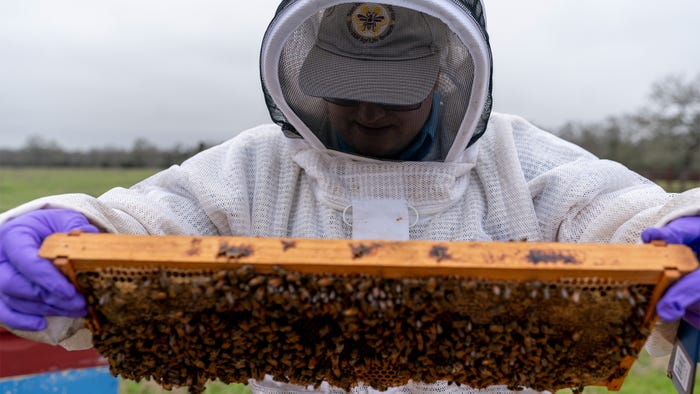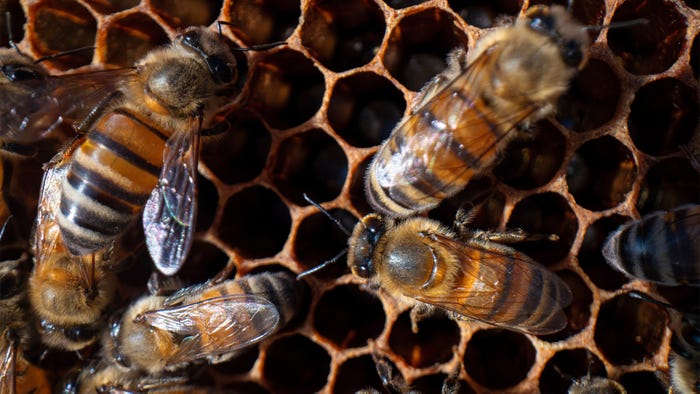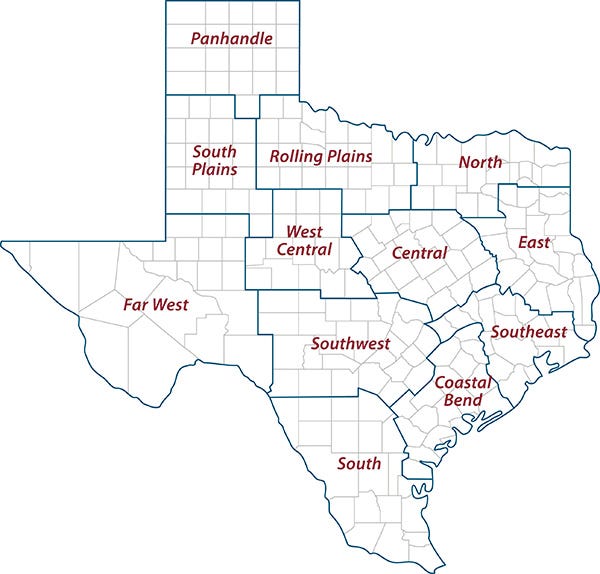Less weather extremes sweeten honey production numbers
As beekeepers finish up their last fall harvest, honey production is looking better than last year, according to a Texas A&M AgriLife Extension Service expert.
Garrett Slater, AgriLife Extension honeybee specialist and assistant professor in the Texas A&M Department of Entomology, works to support the state’s commercial and hobby beekeepers and is based at the Texas A&M AgriLife Research and Extension Center at Overton. He said while the numbers are still coming in, overall, Texas is seeing better honey production after a tough 2023.

Honey production was significantly lower. (Photo by Michael Miller, Texas A&M AgriLife)
The U.S. Department of Agriculture National Agriculture Association Service’s latest statistics on honey production showed that Texas honey production dropped to less than $12 million in 2023 compared to more than $27 million in 2022. Prices per pound were also down 24 cents per pound.
“Last year was a bad year for honey producers,” Slater said. “Honey production was significantly lower in 2023 compared to any number from the past 10 years.”
Recovering from a rough 2023
Not only were production and prices down, the number of honeybee colonies dropped. Slater said the number of honey-producing hives – 360,000 in 2022 – declined by 55,000 hives in 2023.
Hives can be affected by a number of factors including the loss of a queen, pesticides, disease and extreme weather — including freezing temperatures, excessive rains, very high temperatures and drought. Last year, brought a range of weather-related challenges to beekeepers resulting in colony loss and lower production.
Slater said less extreme weather swings and milder summer temperatures contributed to improved conditions for bee colonies and honey production.

The weather in 2024 was better for bees. (Photo by Michael Miller, Texas A&M AgriLife)
“The weather was better for the bees this year, so I’m expecting to see stronger numbers once we have the final report from the harvest,” Slater said.
Texas ranks third in the nation for honeybee colonies and seventh for honey production.
AgriLife Extension district reporters compiled the following summaries:

Central
Drought conditions affected the entire district, and conditions were declining. Temperatures were cooler in the morning but warmed up to near- or record-high temperatures. Most pastures were in fair condition but were starting to show signs of stress. Stock tanks continued to dry down. The weather was favorable for harvesting peanuts, pecans, hay and cotton, which were close to wrapping up, but conditions were not good for dryland small grain crops. Most small grains planting stopped until it rains, and most planted fields failed to emerge, or emerged fields were dying off. The cattle, sheep and goat markets looked good. Livestock were in good condition despite beginning to run out of pasture. Stockpiled forages and supplements were given to livestock.
Rolling Plains
Unseasonably hot and dry conditions persisted in the district. Wheat planting slowed. Some farmers were still trying to dry plant with hopes of rain in the coming week, and others held off for planting after rain. Cotton fields not declared as failed were expected to yield very poorly. Rain was needed to replenish livestock drinking sources and help grass growth. Cattle prices were favorable for producers who continued to cull their herds. High winds and dry vegetation had all counties concerned about wildfires breaking out. Most of the district remained under a burn ban, with red flag warnings due to the dry conditions.
Coastal Bend
Dry, unseasonably hot conditions persisted, with no rain for 60 days and temperatures still in the 90s. Soil moisture remained low, limiting fall fieldwork and bedding to lighter soils. Grain producers arranged fertilizer and seed for the new year, but winter pasture planting was minimal so far due to high costs and lack of moisture. Pastures were dormant and drying out, with some producers feeding hay to livestock. Hay remained plentiful, but supplemental feeding increased significantly in heavily stocked areas. Cattle remained in good condition, while numbers at area sale barns remained high. The pecan harvest started.
East
Drought conditions persisted in the district with burn bans issued in most areas. Ponds and creeks continued to dry up. Producers had mostly decided to hold off on planting winter pastures until rain arrived. Hay production wrapped up for the year. Livestock were in fair to good condition, with some supplementation taking place.
Southeast
Soil moisture levels were adequate to very short. Most of the counties implemented burn bans due to extremely dry conditions. Conditions were hot and dry, but there were chances of rainfall in the forecast for some areas. Planting winter forages like ryegrass and oats was delayed due to drought conditions. The lack of winter grazing may cause an increased demand for hay this winter. Pastures were getting dry, and the pond levels were dropping. Rangeland and pasture ratings varied from fair to very poor. The cotton harvest was wrapping up.
South Plains
Drought conditions continued for most counties. Some very brief showers were received in the southeastern part of the district this past weekend. Farmers continued to defoliate cotton and strip fields that were ready. Winter wheat was still being planted, but much of it had not emerged due to the very dry conditions. Cattle were in good condition.
Panhandle
Conditions remained very dry. Overall, soil moisture levels were reported from adequate to very short. The corn and grain sorghum harvests continued, and forage sorghum continued to be chopped as fields dried to suitable moisture contents. The cotton harvest was getting underway as harvest aid applications were applied to most fields within the past few weeks. Upper-canopy bolls had opened nicely given the number of sunny, relatively warm days available to reach final maturity. There were no major wind or storm events that would have degraded the cotton fiber. Any additional rainfall would help recently emerged small grain and winter cover crops. Supplemental feeding of cows continued. Pasture and rangeland conditions were very poor to fair, with overall crop conditions reported as poor to good.
North
Pasture and rangeland conditions were very poor to fair. The subsoil and topsoil moisture levels were short. Days were dry and hot, with no rain reported. Soil and vegetation were showing drought stress. Livestock conditions were fair, but declining water sources continued to lower water quality. The cotton harvest continued. Some hay harvest occurred. Some wheat planting took place, while some was delayed or slowed due to drought.
Far West
Temperatures were above normal, and conditions remained dry. Some parts of the district were significantly worse off than other areas. Soil moisture was critically low and hindering wheat planting and seed germination. Wheat continued to be planted, but earlier-emerged oats and wheat needed rain. Farmers cut and baled late-season hay. Many cotton fields were shredded due to bolls falling off from extreme heat. The cotton harvest on irrigated acres was ramping up. Early varieties of pecans were being harvested at average prices. Winter grass growth slowed due to dry conditions, with reports of armyworms on early planted wheat. Supplemental feeding continued for livestock, which remained in good condition despite the dry pastures.
West Central
The weather was warmer than normal and dry, with highs reported in the low 90s and lows in the upper 50s. No precipitation was reported, and winds were high. Cotton yields were coming in much lower than expected, with a large majority of cotton fields being zeroed out due to drought. Wheat was suffering, and armyworms were being reported in fields. Fields planted with seeds treated against armyworms were not being eaten, but overall most wheat fields had yet to emerge. The district needed rain to improve soil moisture, rangeland and growing conditions. Livestock were in fair condition, and there was a continued need to feed livestock and wildlife.
Southwest
Dry, warm conditions persisted. Temperatures rose back into the high-80s, with no rain in sight. Soils remained dry with visible cracks, and forage availability dwindled. The last cotton bales were hauled to the gin. The pecan harvest was completed. High temperatures and a lack of moisture prevented cool-season forage from germinating, while warm-season plants continued to go dormant. There was a significant amount of dry fuel that could contribute to fire risks. Irrigated oats and wheat looked fair, but pastures and rangelands dried up due to above-average temperatures and insufficient rainfall. Water well levels were a concern, and Canyon Lake’s levels dropped to the point that stricter water restrictions were anticipated. Livestock received supplementation and were mostly in fair condition. Wildlife were active, with whitetail bucks beginning their rut. There was a slight chance of rain in the forecast, with cooler temperatures expected.
South
Mild to warm temperatures continued with no rainfall reported, causing topsoil and subsoil moisture levels to decline. Temperatures ranged from the 60s to low-90s, and reports of roadside fires increased due to hot, dry conditions. Agricultural conditions were poor across many areas due to the lack of rain and no water in irrigation canals. Most crops were harvested, and fieldwork was mostly at a standstill. Peanut and sesame harvesting continued, and strawberry planting was near completion. Winter and fall vegetables were still being planted or harvested, with fall corn progressing well. The citrus harvest, and planting of onions and leafy greens continued. Forage producers made their last cuts for the season. Rangeland and pasture conditions varied, but many areas reported declining conditions. Stock tank levels remained low. Ranchers increased feed supplementation due to cooler nights and drought affecting grass growth, and beef cattle markets saw steady volumes with slight price drops. Calf and cull cow sales rose due to drought, with higher numbers of cattle sold at local auctions. Ranchers were selling calves early to benefit from higher prices on 400-500-pound calves, while feed prices remained high.

